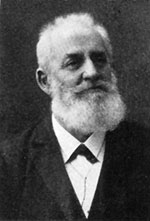Magnificent graphical drawings of the reconstruction of the state of the castle ruin in 1436 are presented in several large display cabinets placed in front of the ticket office. The artist of the paintings is the Vienna architect Eduard Reithmayer (1844-1931) who in 1900 attempted to “illustrate the castle in pictures and images according to its most probable past condition”. The monograph written by Reithmeyer in 1911 recording all his conducted studies and site measurements, which over many decades was completed with extreme personal commitment and dedication, received enormous national recognition. Reithmeyer was subsequently appointed as “correspondent of the royal imperial central commission for arts and historic monuments” (k. k. Zentral-Kommission für Kunst und historische Denkmale).
 |
Recorded in his autobiographical
comments, Reithmeyer confessed that he was only marginally engaged
in castles before 1900, then dared to make the leap into the
audacious scene of reconstruction he consequently had to study the
relevant literature about castles. |
The final product being a gigantic stony
structure built for combat. At least 200 defenders were needed to man the
many vertical and horizontal levels of the castle, but around 1430 only a
dozen men were fit for military service. For his fictive chambers
Reithmeyer even produced detailed floor plans, sectional drawings and
functional plans. The Fortified House (“Feste Haus”) on the “Bürgel” is
characteristic for his misinterpretations. Reithmayer misunderstood the
drawings from 1542 (see below), he mistakenly assumed that the building
was an enormous keep, even though it was built on such weak foundations.
Due to its spectacular altitude the castle would never have needed such a
keep.
Reithmayer is a congenial example of how the perception of castles in the
19th century was completely exaggerated, both in the dimensions
of the castles as well as in the defence elements in order to adapt them
to a freely invented image of the Middle Ages.